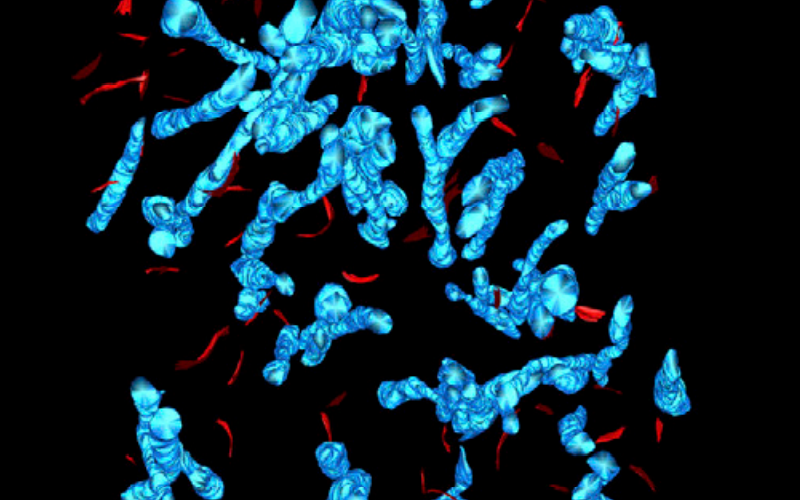Studying the Biology of Alzheimer’s Disease: A Q&A with Annalisa Scimemi

By Erin Frick
ALBANY, N.Y. (Dec. 15, 2022) — Alzheimer’s disease is the most common cause of dementia, affecting more than six million people in the United States. The condition is marked by damage to neurons — nerve cells in the brain that control essential functions like thinking, movement and sensory processing. Over time, nerve damage leads to memory loss and impaired cognition. There is a growing understanding that other cell types play a role in this disease.
Annalisa Scimemi, associate professor of Biological Sciences at the College of Arts and Sciences, was recently awarded $1.16 million to study molecular and cellular processes that contribute to Alzheimer's disease onset. The project focuses on astrocytes, a type of non-neuronal cell in the brain, and a technique called optogenetics — using light to control brain activity. Scimemi’s lab is at the forefront of this technology, which relies on a multidisciplinary blend of electrophysiology, imaging, computational and behavioral approaches.
We caught up with Scimemi to discuss plans for how the work could support new approaches to Alzheimer’s disease treatment. The project is supported by the Seattle Institute for Biomedical and Clinical Research.

What prior research by your lab preceded this new project?
Broadly, our lab is working to understand neuron-to-neuron communication in the brain. Our focus is synapses — the points of contact between nerve cells where neurotransmitters (chemical messengers that send signals through the brain), are released and received.
Adjacent to neurons and synapses are small membrane protrusions formed by cells called astrocytes. Astrocytes act as molecular "Hoovers" which clean up leftover neurotransmitters that are no longer being used for synaptic communication. When astrocytes malfunction, neurotransmitters linger in the brain for longer than they should, causing neurotoxicity. Astrocyte failure is thought to play a role in Alzheimer’s disease onset.
We also know that abnormal protein accumulation, in the form of “plaques” and “tangles,” occurs in the brains of people with Alzheimer’s disease. Plaques accumulate between neurons while tangles build up inside them. Both worsen over time and contribute to cell death and brain shrinkage. These abnormalities typically begin in areas of the brain responsible for memory. Part of our study will focus on understanding how these proteins alter the function of astrocytes.
What is astrogliosis, and what is its connection to Alzheimer's disease?
The term “astrogliosis” refers to a collection of molecular changes in astrocytes that lead to their dysfunction. These include things like cellular swelling, changes in their genetic makeup and inability to clear away extra neurotransmitters.
Astrogliosis is a signature feature of Alzheimer’s disease, yet most research to date has focused on neurons, with little attention to other cell types, like astrocytes. If we can determine how Alzheimer’s disease starts disrupting astrocytes, we may be able to delay disease progression and find new targets for intervention.
What are your plans for this work?
We will use a technique called electrophysiology, combined with optogenetics, to control the activity of cells in the brain using light. This will allow us to study how abnormal protein structures in the brain affect communication between nerve cells and their ability to perform essential functions.
To do this, we will inject viral particles into the brain, which carry their DNA to targeted cells, encoding proteins that typically accumulate in the brain with Alzheimer’s disease. We will then record the electrical activity of neurons and astrocytes, to determine how accumulated proteins (plaques and tangles) alter the functioning of these cells.
This research will be carried out at UAlbany in collaboration with colleagues in Seattle and Boston Children's Hospital. Our team includes neuroscientists with expertise in genetics, neuropathology, cell biology and cell physiology.
How is your approach unique?
Most Alzheimer’s research has focused on genetic forms of the disease, including types that run in families, as well as rare forms. However, more than 95% of Alzheimer’s disease cases are idiopathic, meaning that there is no identifiable cause.
We are aiming to understand how astrocyte dysfunction contributes to the onset of this more common form of Alzheimer’s disease, before symptoms occur.
How can this work support Alzheimer’s disease treatment?
Our lab focuses on basic research, so clinical applications are a few steps removed. That said, science relies on teamwork, wherein basic and clinical scientists use complementary approaches to advance a common goal. Like in soccer, we can win the game if we have not only a good attack, but also a good defense and goalie. With this spirit in mind, our aim is to contribute a more detailed understanding of how astrocytes disrupt neuron-to-neuron communication in the brain at an earlier stage of disease progression, to help identify new targets for therapeutic intervention for idiopathic Alzheimer’s disease and aging.
What are you most excited about, as you undertake this project?
This project presents an exciting opportunity to train students and deepen their understanding of the brain using state-of-the art tools like electrophysiology and optogenetics. Neuroscience is a field that melds disciplines, and this project is a robust example of that collaboration. I hope this approach will help us imagine new ways to advance scientific discovery at UAlbany, while encouraging students to think creatively about the research process.




